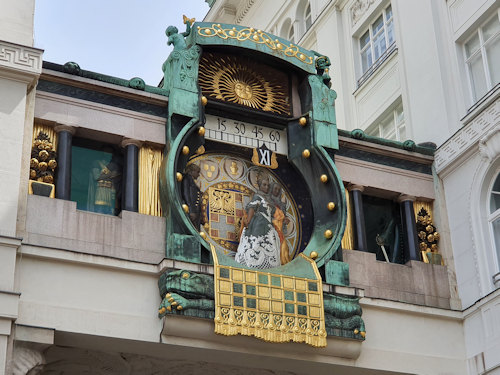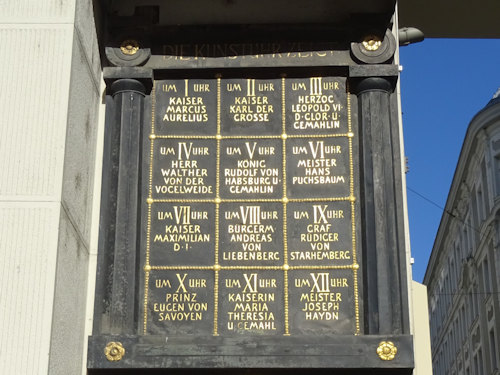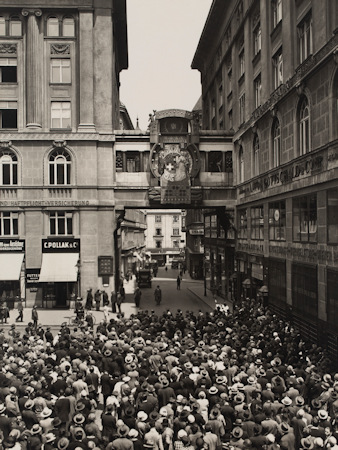
If you wander up the Hoher Markt street in Vienna’s centre at the top of the hour, expect to see a crowd of people peering up expectantly at an insurance building. The object of their fascination: a clock called the Ankeruhr.
- Jugendstil mechanical clock built in 1914
- 12 historical figures rotate slowly around the front
- Be there at midday when the figures do a complete turn
- Book a themed guided tour* of Vienna
- See also:
History of the clock

(The installation links two buildings)
The Ankeruhr is another creation that falls into that turbulent period of Austrian history when modernism, Imperial tradition, and the approaching chaos of war all collided.
The Anker Insurance Company (now Helvetia) built this beautiful Jugendstil clock in 1914 as part of the expansion of their headquarters. The installation represents one of several excellent examples of that design era in the nearby area.
Anker commissioned the work as a contribution to the city’s art and culture, but also as a subliminal reminder of the importance of life insurance; the clock contains various allegorical motifs representing the inevitable passing of time and the transience of human existence.
You have, for example, figures representing Life and Death (with his obligatory hourglass) flanking the sun motif above the centre.

(Empress Maria Theresa is doing her turn)
The whole installation rests on the heads of Adam, Eve, an angel and the devil. The clock itself has a basilisk underneath, though that symbolism escapes me.
The painter and sculptor, Franz Matsch, designed the clock at the height of his fame (he was once a close associate of Gustav Klimt), including the mechanical elements that drive it.
But people don’t collect there just to admire the art and architecture. A set of 12 personalities from Vienna’s past rotates slowly around the minute display, ensuring a new figure appears each hour.
The clock also marks the top of the hour with organ music, each piece matching the individual associated with that hour.
The big excitement and the biggest crowds come at midday, when all twelve Ankeruhr figures go through a complete bonus rotation.
Who are the Ankeruhr figures?

(The roll of honour)
A plaque next to the clock reveals the identities of these rotating coloured copper figures, who represent a journey through Austrian history.
They are:
- Joseph Haydn, who was pretty good at music. The piece played when he appears is from his own oratorio, The Creation. You can actually stand in the very rooms where he composed the piece over at the Haydnhaus.
Haydn turns up between 12 and 1, then subsequent hours reveal…
- The Roman Emperor, Marcus Aurelius, who allegedly died in Vienna (then the city of Vindobona) in AD180. Go one block west to find yourself on Marc-Aurel-Straße
- Charlemagne, who first incorporated “Austria” into the Holy Roman Empire around AD800. Visit the Schatzkammer to see several items that likely belonged to this major historical figure
- Leopold VI, who awarded Vienna its city charter in 1221, and his spouse
- Walther von der Vogelweide, a famous travelling singer of Leopold’s time
- The first Habsburg ruler of “Austria”, Rudolf von Habsburg and his spouse

(The Ankeruhr with its crowd of onlookers somewhere around 1920-1930, as photographed by Martin Gerlach jun.; Wien Museum Inv.-Nr. 226599; excerpt reproduced with permission under the terms of the CC0 licence)
- Hans Puchsbaum, the 15th-century architect and master builder closely associated with Stephansdom cathedral
- Emperor Maximilian I, a significant player in the expansion of the Habsburg monarchy in the early 16th century and a strong supporter of the arts
- Johann Andreas von Liebenberg, mayor of Vienna at the time of the second Turkish siege of 1683. He has his own monument elsewhere
- Ernst Rüdiger von Starhemberg, who led the defence of the city at that 1683 siege
- Prince Eugene of Savoy, military genius, saviour of various Habsburg causes, and builder of Belvedere and Schloss Hof
- The 18th-century Habsburg monarch, Maria Theresa, and her husband
How to get to the Ankeruhr
The clock lies very close to the central square dominated by the cathedral. And close to one of my favourite ice cream parlours: Zanoni & Zanoni at Lugeck 7.
The Hoher Markt itself has a long history that dates all the way back to Roman times (the Roman Museum is on the square), but today’s view seems rather modern for Vienna.
Blame extensive bomb damage in WWII for the disparity. You can see the rubble for yourself in the final scenes of The Third Man (when Holly Martins waits for Harry Lime in a café on the square).
Subway: Take the U3 or U1 to Stephansplatz and walk down
Bus: Take the 2A to Rotenturmstraße or the 1A or 3A to Hoher Markt
Address: Hoher Markt 10-11 | Website